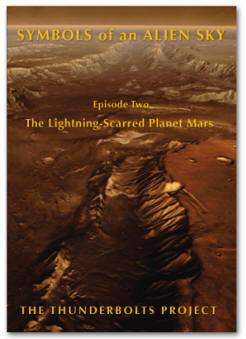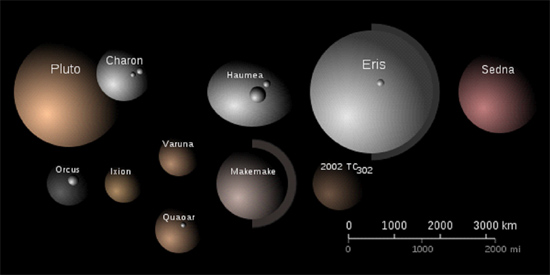"Snow White," otherwise known as
2007 OR10, is a dwarf planet about
13 billion kilometers from the Sun.
Its orbit, canted by almost 31
degrees to the plane of the
ecliptic, is so large that it was
closest to the Sun in 1856 and will
not reach its farthest point until
2130, taking more than 550 years to
revolve.
Snow White joins many other icy
worlds so far from the Sun that it
would be hard to pick out that
luminary from the star field. It is
in a similar orbit with its sister
dwarf Eris (2003 UB313) within a
region occupied by so-called "Trans-Neptunian
Objects" (TNO) or "Kuiper
Belt Objects (KBO)."
Astronomers Kenneth Edgeworth and
Gerard Kuiper proposed a Kuiper Belt
theory in 1951. In 1992, the as yet
unnamed 1992 QB1 was discovered,
confirming the idea that a group of
frigid objects beyond Neptune was in
orbit around the Sun.
Dwarf planets are also part of
the TNO designation, although they
are in a subclass by themselves. In
2006, a
controversial vote was
cast at a
meeting of astronomers in
Prague that provided a way to
classify various celestial bodies.
Four relevant resolutions were
proposed:
Resolution 5A: "Definition of
Planet"
Resolution 5B: "Definition of
Classical Planet"
Resolution 6A: "Definition of
Pluto-class objects"
Resolution 6B: "Definition of
Plutonian Objects"
According to the vote, a "planet"
is a celestial body that orbits the
Sun, has a nearly round shape, and
has "cleared" its orbit of
extraneous debris. Another
classification was added to the
terms used by astronomers: "dwarf
planet." A dwarf planet is
essentially something that looks
like a planet but is not a planet.
Pluto is now considered a dwarf
planet, as is the asteroid Ceres.
Along with the aforementioned Eris
and Snow White, Haumea, Makemake,
Sedna, Quaoar, and Orcus are also
likely to be dwarf planets. Pluto's
moon Charon would also fit if it
were not a moon. There are
dozens more that await
further investigation.
Immanuel Kant's theory that the
Solar System was born from a dusty
cloud of gas, or nebula, floating in
space is known as the "Nebular
Hypothesis." As Kant suggested, the
cloud contracted because gravity
drew the cloud particles together
into clumps. As they grew, the
clumps became more attractive,
finally accumulating into a mass.
The gravitational force became so
strong that it compressed the mass
into a hot ball, rotating with the
cloud's original angular momentum.
It gathered more and more matter
until a nuclear fusion reaction
ignited it, giving birth to the Sun
and a structure called an "accretion
disk" circling its equatorial plane.
The accretion disk is said to
have extended beyond the orbit of
Neptune. According to scientists,
eddies of matter formed in the
spinning ring of dust and gas. Those
eddies grew larger, slowly sucking
in more and more particles until
hundreds of millions of impacts from
nebular condensates gradually formed
the planets. The Kuiper Belt, as
well as the theoretical "Oort
Cloud," are supposed to be "holding
areas" for the remaining material
that did not condense into planets
(or dwarf planets).
In a previous Picture of the Day,
another class of Solar System object
called "centaurs" was discussed. It
was noted that they are what could
be called "cometary asteroids" and
come in several colors:
reddish-brown, blue, green, and
brownish-yellow. As suggested by
this writer, the centaur objects
could be colored because they were
ejected by the gas giant planets;
their colors corresponding to the
colors of their parents.
An interesting characteristic of
the various dwarf planets is that
they, too, are colorful. Snow White,
contrary to its name, is reddish in
color like its sister Haumea. Pluto
itself is brownish-yellow, while
Eris is green.
In a plasma cosmogony hypothesis,
the stars are formed when cosmic
Birkeland currents twist around one
another, creating z-pinch regions
that compress the plasma into a
solid. Laboratory experiments have
shown that such compression zones
are the most likely candidates for
star formation and not collapsing
nebulae. When stars are born, they
are probably under extreme
electrical stress. In that case,
they will split into two or more
daughter stars, thereby equalizing
their electrical potential.
"The fission process is repeated
in further electrical disturbances
by flaring red dwarfs and gas giant
planets ejecting rocky and icy
planets, moons, comets, asteroids
and meteorites. Planetary systems
may also be acquired over time by
electrical capture of independent
interstellar bodies such as dim
brown dwarf stars. That seems the
best explanation for our ‘fruit
salad’ of a solar system."
Wal Thornhill
When
New Horizons arrives at
Pluto in July 2015, Electric
Universe theorists expect the
Nebular Hypothesis to be falsified
again, as it has in the past. 99% of
the Universe is plasma, so the
conclusions derived from the
Hypothesis are not connected with
real observations.
Stephen Smith
 New
DVD
New
DVD
The Lightning-Scarred
Planet Mars
A video documentary that could
change everything you thought you
knew about ancient times and
symbols. In this second episode of
Symbols of an Alien Sky, David
Talbott takes the viewer on an
odyssey across the surface of Mars.
Exploring feature after feature of
the planet, he finds that only
electric arcs could produce the
observed patterns. The high
resolution images reveal massive
channels and gouges, great mounds,
and crater chains, none finding an
explanation in traditional geology,
but all matching the scars from
electric discharge experiments in
the laboratory. (Approximately 85
minutes)
Video Selections
Order Link





 New
DVD
New
DVD

